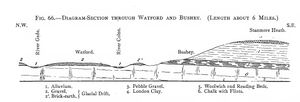Excursion to Watford. May 1st, 1875 - Geologists' Association excursion
| From: A record of excursions made between 1860 and 1890. Edited by Thomas Vincent Holmes , F.G.S. and C. Davies Sherborn, F.G.S. London: Edward Stanford [For the Geologists’ Association], 1891. Source: Cornell University copy on the Internet Archive (Public domain work) |

Directors: Dr. John Evans, F.R.S., Prof John Morris, F.G.S., and John Hopkinson, F.G.S. (Proc. Vol. iv. p. 284 )
In consequence of very unfavourable weather, the programme of this excursion was shortened. After assembling at Holly Bank, the residence of Mr. Hopkinson, the party crossed the country to the east of Watford, through which runs the Colne, in a Chalk valley with an alluvial bottom and slopes covered in places with gravel. On the further side of this valley, Professor Morris, illustrating his remarks by specimens taken from the spot, described the gravel as Drift re-arranged and re-distributed by fluviatile action, since not merely rolled portions of flints, but sub-angular pebbles of quartzite, sandstone, lydian-stone, and fragments of other rocks, found only at considerable distances to the north and west, occur abundantly in the gravels of this and other valleys subsidiary to the great Thames Valley.
At Berry Wood a pit exposes the Chalk, with a very irregular surface, underlying a capping of Drift. Dr. Evans interested the party by producing perfectly regular cones from Chalk flints, by simply striking the flint nodules sharply with a hammer, the impact of the hammer causing an increased density of the particles composing a .cone the apex of which is the point of impact.
This Chalk-pit is close to the river Colne, which at this place runs parallel with, and at a short distance from, the northern edge of the London Tertiary Basin. The Colne receives the rainfall of a considerable Eocene area, which, after percolating through the Drift and Lower Eocene sands, passes into the Chalk, and subsequently makes its way into the river, in some cases by springs in or close to its bed. In the grounds of Otterspool are several of these springs, giving forth never-failing streams of clear water. Six are at the bottom of the pool, and, together, yield a very large quantity of water a day, forming a not inconsiderable affluent of the Colne. The party, through the kindness of Mr. S. T. Holland, visited this remarkable and picturesque pool, which, by a sounding, was found to be 16 feet deep; but so clear is the water, that the chalk bottom and even the springs in the deepest part could be distinctly seen.
On returning to Watford, the party were hospitably entertained by Mr. and Mrs. Hopkinson.